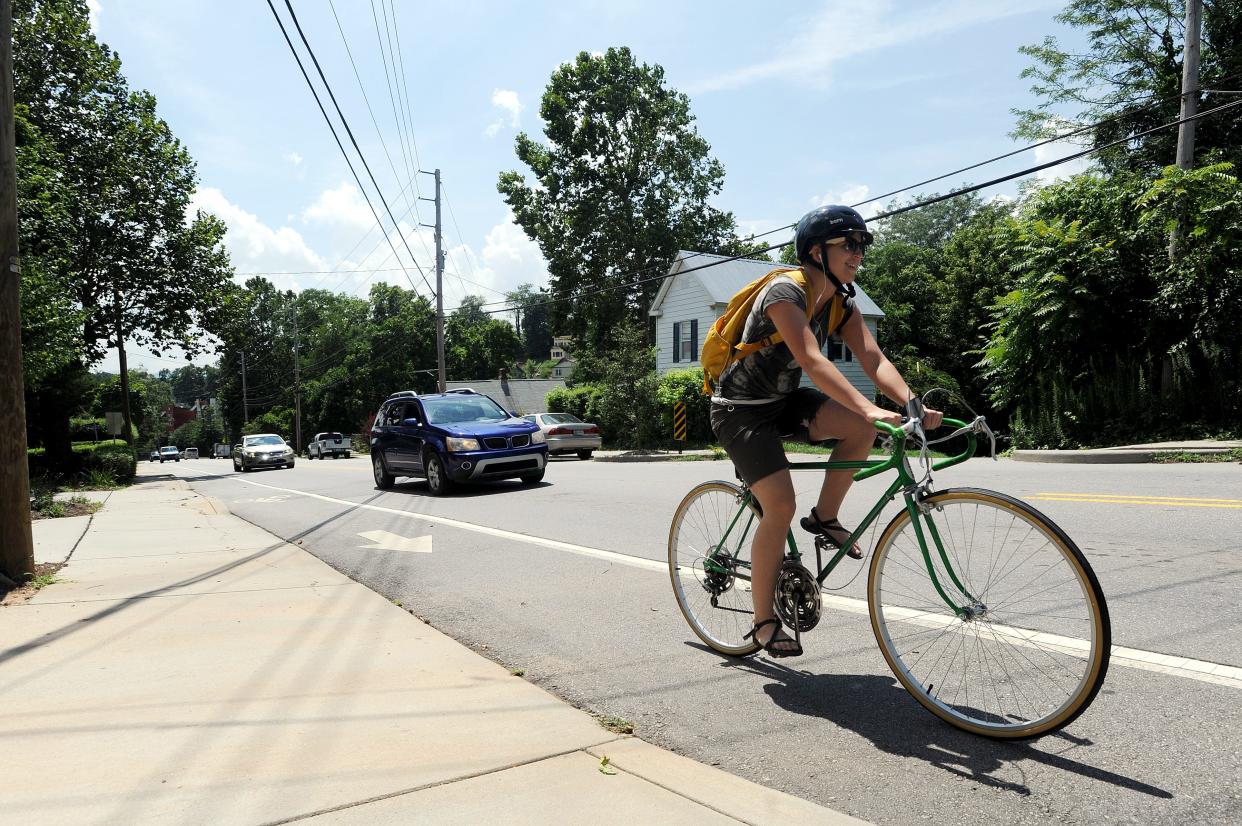Answer Man: What’s the law on distance between bikes, cars in North Carolina?

Today’s burning question revolves around the laws regarding cars, bicyclists and pedestrians. Got a question for Answer Man or Answer Woman? Email Executive Editor Karen Chávez at KChavez@citizentimes.com and your question could appear in an upcoming column.
Question: I am an active retiree who enjoys walking, jogging and biking along Buncombe County roads in my neighborhood. Around 99% of cars seem to slow down and/or gently swerve into the oncoming lane to allow me safe passage with a good margin of safety. Every now and then a driver does not slow down and/or steer away to allow a comfortable margin of safety. Is there a law that dictates a specific minimum distance between motorized vehicles and unpowered pedestrians or bicyclists when a vehicle passes? Somehow I thought there was a 36-inch minimum passing distance. Is that true in NC?
Answer: There’s a slew of state laws dealing with this issue.
On highways the driver has to give the cyclist at least 4 feet of distance.
North Carolina State Highway Patrol 1st Sgt. Christopher Knox pointed me in the direction of a piece of state law that details “limitations on privilege of overtaking and passing.”
“The driver of the faster moving vehicle either (i) provides a minimum of four feet between the faster moving vehicle and the slower moving vehicle or (ii) completely enters the left lane of the highway,” the law says.
More: Bicyclist dies after being hit by SUV on Hendersonville Road; driver charged
More: Asheville PD: Mars Hill man charged with cyclist's murder after Grove Street hit-and-run
More: Asheville PD: Cyclist dead after Grove Street hit-and-run
Since this reader referenced the county, I reached out to the Buncombe County Sheriff’s Office as well. Aaron Sarver, a spokesperson for the Sheriff’s Office, pointed me in the direction of other statutes.
Those say that where “sidewalks are provided, it shall be unlawful for any pedestrian to walk along and upon an adjacent roadway.”
Where they are not, “any pedestrian walking along and upon a highway shall, when practicable, walk only on the extreme left of the roadway or its shoulder facing traffic which may approach from the opposite direction. Such pedestrian shall yield the right-of-way to approaching traffic.”
Finally, City of Asheville spokesperson Kim Miller said that “North Carolina law deems bicycles and electric assisted bicycles as vehicles. North Carolina General Statute § 20-149 requires a driver to leave at least two feet to the left of the vehicle they are passing another vehicle, which includes bicycles.”
More: Answer Woman: Are the Merrimon Avenue bike lanes open? If not, when?
This is just a sampling of different laws and what they say. Different people at different agencies will choose different charges for different violations. And by the time someone has hit a cyclist or a pedestrian and it reaches the courts, prosecutors and defense attorneys can of course debate whether specific statutes apply or don’t.
But what about best practices?
Asheville on Bikes Executive Director Mike Sule pointed me in the direction of BikeWalk NC, “a membership-based, statewide advocacy organization promoting non-motorized transportation choices for residents of and visitors to NC.”
Some guidelines from the group that cite statute and the North Carolina Driver’s Handbook:
More: Answer Man: More soccer fields ready soon west of Asheville? And ... pickleball?
“Faster drivers must yield to slower and stopped traffic ahead. All vehicle operators must travel no faster than is safe and will allow them to stop within their sight distance. This legal principle is known as assured clear distance ahead.”
“Slow or stopped traffic may be present on any road at any time. Drivers must always be prepared to encounter garbage trucks, school buses, farm tractors, construction equipment, police officers, pedestrians, bicyclists and traffic congestion on most roads. Driving in a way that would endanger other road users who are stopped or traveling slowly is unlawful.”
“Most drivers have no difficulty limiting their speed and seeing and slowing in time to avoid hitting vehicles traveling slowly ahead on the roadway. Impaired driving, reckless driving, distracted driving and bicycling at night without an adequate rear light or reflector are the primary contributing factors in car-bike collisions where motorists fail to slow in time to avoid rear-ending slower bicyclists.”
Ryan Oehrli covers public safety, breaking news, courts and other beats for the Citizen Times. Comments? Questions? Tips? Send them to coehrli@citizentimes.com or 252-944-6816. Please support local, daily journalism with a subscription to the Citizen Times.
This article originally appeared on Asheville Citizen Times: What’s the law on distance between bikes, cars in North Carolina?

